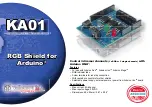
SmartPLC DataLine with Profinet device interface
160
>
Device diagnosis alarms
41579
Alarm type ID
Description
Slot / sub-slot /
channel
Alarm parameter
0x0100
internal device system error
cause of error
alarm parameter
0 / 1 / 0x8000
cause of error
0x0101
excess temperature: temperature inside the device
has exceeded the permitted max. value of 80 °
celsius.
0 / 1 / 0x8000
device temperature
0x0104
the gateway mode is deactivated
0 / 1 / 0x8000
--
>
AS-i diagnosis alarms
41541
Alarm type ID
Description
Slot / sub-slot /
channel
Alarm parameters
0x0200
internal system error of an AS-i master
M / 1 / 0x8000
master number, cause of error
0x0202
AS-i master was set to the projection mode
M / 1 / 0x8000
master number
0x0203
new slave 0 was detected
M / 1 / 0x8000
master number
0x0204
earth fault was detected
M / 1 / 0x8000
master number, symmetry
0x0207
22.5 V AS-i power failure was detected
(classic ASi power)
M / 1 / 0x8000
master number
0x0208
19 V AS-i power failure was detected (Power24)
M / 1 / 0x8000
master number
0x03(SLA)
configuration error, too many slaves
M / 1 / 0x8000
master number, slave address
0x04(SLA)
configuration error, slave missing
M / 1 / 0x8000
master number, slave address
0x05(SLA)
configuration error, slave has wrong profile
M / 1 / 0x8000
master number, slave address
0x06(SLA)
periphery fault
M / 1 / 0x8000
master number, slave address
0x0701...0x071F double addressing fault
M / 1 / 0x8000
master number, slave address
Legend:
M
master no.
1 bit
0 = AS-i master 1
1 = AS-i master 2
SLA
slave address
1 byte
slaves 1(A)...31(A):
slaves 1B...31B:
0x01…0x1F = 1…31
0x21…0x3F = 33…63
Configuration and periphery faults are signalled in slot 1 for AS-i master 1 and in slot 2 for AS-i
master 2. The subslot is always 1, the channel always 0x8000.
The alarm type ID indicates ...
- the type of error occurred (with the high byte of the alarm type ID)
- the slave address causing the error (with the low byte of the alarm type ID).
If there is more than one slave address causing an error, several alarms are sent. The alarms are
independent of each other and remain set as long as the reason for the alarm exists.
The following tables list the complete assignment of alarm type ID by error type and slave address.















































